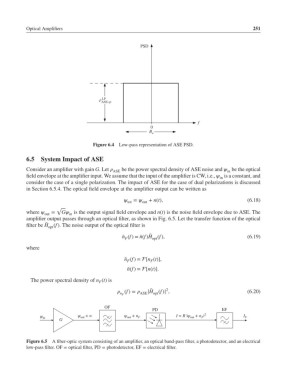Page 270 - Fiber Optic Communications Fund
P. 270
Optical Amplifiers 251
PSD
ρ LP
ASE,sp
f
0
B o
Figure 6.4 Low-pass representation of ASE PSD.
6.5 System Impact of ASE
Consider an amplifier with gain G.Let ASE be the power spectral density of ASE noise and be the optical
in
field envelope at the amplifier input. We assume that the input of the amplifier is CW, i.e., is a constant, and
in
consider the case of a single polarization. The impact of ASE for the case of dual polarizations is discussed
in Section 6.5.4. The optical field envelope at the amplifier output can be written as
= + n(t), (6.18)
tot out
√
where = G is the output signal field envelope and n(t) is the noise field envelope due to ASE. The
out in
amplifier output passes through an optical filter, as shown in Fig. 6.5. Let the transfer function of the optical
̃
filter be H (f). The noise output of the optical filter is
opt
̃
̃ n (f)= ̃n(f)H (f), (6.19)
F opt
where
̃ n (f)= [n (t)],
F F
̃ n(f)= [n(t)].
The power spectral density of n (t) is
F
2
̃
(f)= ASE |H (f)| , (6.20)
opt
n F
OF
PD EF
ψ ψ out + n ψ out + n F I = R |ψ out + n | 2 I F
F
in
G
Figure 6.5 A fiber-optic system consisting of an amplifier, an optical band-pass filter, a photodetector, and an electrical
low-pass filter. OF = optical filter, PD = photodetector, EF = electrical filter.

